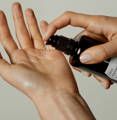Hello, there are currently no products in your shopping cart. Start your shopping.
Log in or register to get 4 free samples!If you don't want to register, don't worry— you can still choose 2 free samples with every order.
Published: September 7, 2022
Exfoliation is touted as a quick and easy way to give your skin a radiant glow. And it is. We lose around 500 million skin cells every day, so dead skin can build up pretty quickly.
A quick exfoliating session can instantly reduce dullness for a fresh dewy face. But over-exfoliation is a bad thing. And it’s a skincare mistake that’s easily made. By incessantly scrubbing off dry, flaky patches of skin (in an effort to rid yourself of it!) you can accidentally exfoliate too much. Or use an ingredient that's too harsh for your skin.
We’re diving deeper into exfoliation and breaking down how often you should exfoliate and the best ingredients to use for your skin type.



Just like choosing an exfoliator is dependent on your skin concerns, how often to exfoliate depends in part on your specific skin type.
People with dry skin or sensitive skin should only exfoliate once or twice weekly. These skin types should stay away from harsh exfoliants, which can irritate, leading to further dryness or sensitivity. An enzyme is best if you're sensitive, but a glycolic acid is better if you're prone to dry skin. If you'd rather use a physical exfoliator, choose one with ingredients like bamboo or rice powder.
Oily skin types prone to blackheads and breakouts can exfoliate two or three times a week if their skin can tolerate it. A tea tree oil face serum or salicylic acid are the preferred ingredients for deep exfoliation. If you have oily skin, you may want to incorporate physical exfoliation to deep clean your pores and remove any extra buildup.
If you have normal skin or combination skin, you can use either physical or chemical exfoliation two to three times a week. Try scrubs, acids, and enzymes to find which works best for you, Look for ingredients like mandelic acid, which is harsh on excess oil but mild enough for drier areas.
There are a few major problems with exfoliating every day. To start, exfoliating every day strips the skin of its natural oils. As a result, the skin overproduces oil to compensate, which can cause breakouts.
Additionally, too much exfoliating can cause skin irritation and inflammation, since you're removing the top layer of your skin before it has time to heal. Over time, this habit can actually slow your body's natural cell turnover and can lead to accelerated aging.
Just like the skin on your face, the benefit of exfoliating your body is to break down and remove dead skin cells from the top layer of the skin and unclog pores to reveal fresh, new skin cells for a smoother appearance. But you don’t follow the same rules when you’re exfoliating your body. The skin on your body is thicker and drier and requires heavier tools. Stick to physical exfoliants like sugar, salt, and coffee grinds. Try to exfoliate your body at least once every 10 days, but we recommend one to two times a week if you have sensitive skin, and three to four if your chest and back are on the oily side.
Follow these tips for vibrant skin without over-exfoliation damage.
For most people, exfoliating two to three times per week is a safe and healthy frequency. Ideally, apply an acid serum two to three nights a week and add in an exfoliating mask or peel once a week. If you're wondering how to get glowing skin, encouraging the top layer of dead skin cells to turnover is the secret to glowing, smoother skin.
Check with a board-certified dermatologist before exfoliating if you have chronic acne, as irritating already inflamed skin can leave behind dark spots. You should also hold off on exfoliation if you have any kind of cut or cold sore on your face (it can spread) or if you're sunburned.
If you have healthy, normal skin, exfoliating is one of the most important things you can do for the overall health and appearance of your complexion.

HOW TO GET RID OF TIRED EYES
Learn what causes dark circlers or puffy eyes and how to successfully reduce their appearance.
10 BEST ANTIOXIDANTS FOR SKIN CARE
Learn more about antioxidants and combat fine lines and preserve youthful skin.